Silent Hill: The Short Message is, as the title suggests, short. It will probably take you less than three hours even if you read all the scattered notes in the environments, but considering that it’s a free-to-play game, we can forgive it for that. However, the actual game is very different. The Short Message doesn’t do any of that.
Instead, it tries to forcefully insert a plot with a cast of characters to interact with through text messages and short FMV videos. Although the visual effects of each scene are stunning and the soft murmurs of the sound direction create the right atmosphere, too often the mood is destroyed by the input of the various characters. When the game shows you antidepressants and your character says “I don’t need them,” you realize Anita’s depression. Similarly, showing scenes of self-harm, hearing the mother’s voice yelling at her and saying she doesn’t deserve the food she’s giving her is absolutely forced in its execution.
There are often scenes of bullying where students throw shoes and shout names, but real bullying rarely manifests in this way: it’s more nuanced and silent. That’s why it’s so terrifying, because it can continue for a long time without being noticed. These sections of the story are punctuated by long chase sequences in which, if caught, you’re sent back to the starting point, in what quickly becomes an infinite loop of frustration. The monster doesn’t follow a predetermined path, but there are points to reach to trigger its next move and find the way to go.
It’s a game of trial and error, where you need to play overly long sequences multiple times, unless you miraculously stumble upon the right solution on the first try. The biggest problem with The Short Message is that it’s not scary. Not even a bit. When we saw a poster of the popular creepypasta Jeff the Killer on a wall, we laughed heartily.
It’s written in the way bullying, suicide, self-harm, and overly dramatic teenage girls are often portrayed in the media, and that makes the portrayal immediately come across as a cliché. Maybe we don’t know why we’re trapped in the Villa or why we’re being chased, but we know all the intimate details of Anita’s and her friends’ personal lives, and this prevents us from getting the chills. If you’ve ever played a game by David Cage, you can understand the level of nuances we’re talking about. *Written by Georgina Young for GLHF* © ALL RIGHTS RESERVED
